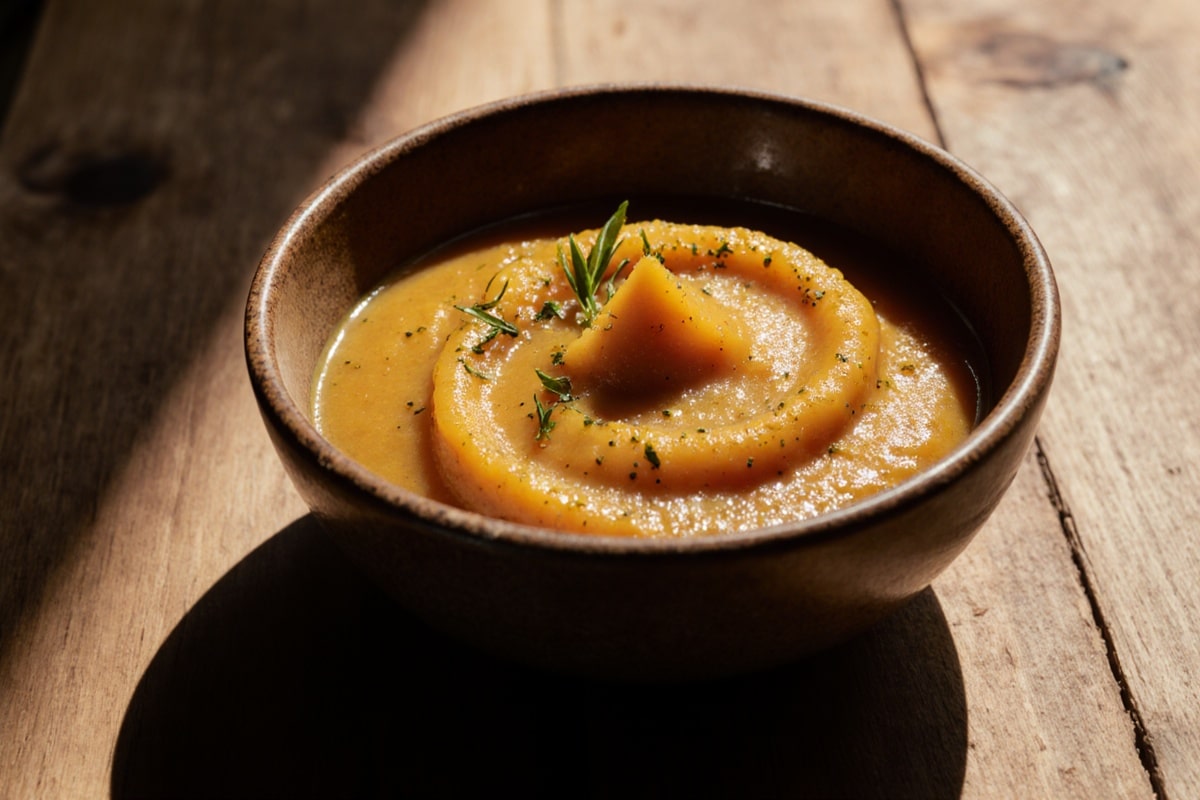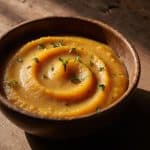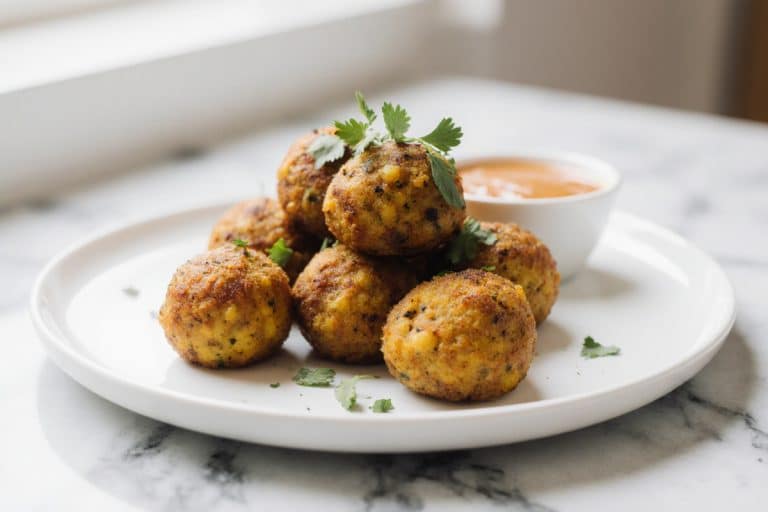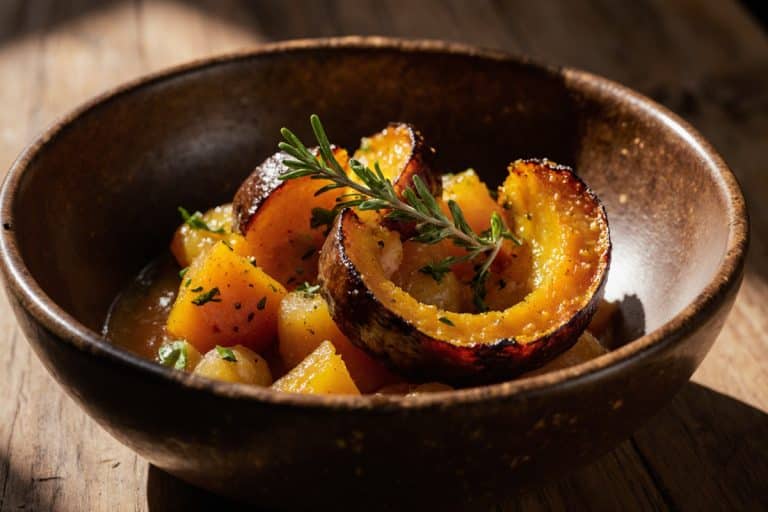Gordon Ramsay Butternut Squash Puree Recipe
Gordon Ramsay butternut squash puree transformed my approach to side dishes. I remember the first time I tried to make it; I ended up with a watery mess that made my guests take one look and push their plates away. But mastering this silky, vibrant puree is a game-changer for elevating any meal. With just a handful of ingredients, you can whip up something so rich and flavorful that it feels like a culinary hug. Trust me, you’ll save time, boost your kitchen confidence, and impress everyone with your newfound technique. Let’s get that squash sizzling!

The Gordon Ramsay Butternut Squash Puree — ingredients, yields and the no-nonsense method
Exact ingredients, weights and expected yield for a dinner portion
1 medium butternut squash (about 900–1,200 g whole) — peeled, halved, seeded and cubed to give ~700 g prepared squash. I aim for about 700 g of raw, trimmed squash to finish with a silky batch for 3–4 people.
40 g unsalted butter (or 30 ml olive oil for dairy-free). Use the butter for richness; swap to oil if you want a cleaner, dairy-free finish.
60–90 ml double cream or 60 ml plain yogurt for lighter texture (optional). I keep cream optional so you can dial the silkiness without drowning the squash.
6 g fine sea salt (adjust to taste) and 2 g black pepper. Start conservative and taste — it’s easy to add salt, hard to take it away.
15–20 g maple syrup or honey (optional, for sweetness balance). Use sweetener only if the squash lacks natural sweetness or your roast went a bit flat.
30 ml lemon juice or 10 ml apple cider vinegar (acid to brighten). A splash of acid lifts the whole dish and stops it tasting cloying.
Makes roughly 4 side-dish servings (about 150–200 g per person) or 3 hearty portions. If you want a silky four-person puree, start with 700–750 g cooked squash. The final yield drops thanks to peeling and seeds, so plan for one medium squash per 3–4 people and weigh where you can.
Prep checklist and the only tools you actually need
Peeler, chef’s knife, baking tray (or large sauté pan/air fryer basket/grill tray), blender or immersion blender, fine sieve (optional), kitchen thermometer. I keep my mise en place tight: clean, weigh and line up ingredients before I touch the knife.
Sharp knife and stable cutting board are non-negotiable — most kitchen injuries happen when someone attacks a hard squash with a blunt blade. Score the squash, remove seeds with a spoon, and peel with a Y-peeler, or slice and trim using a sharp chef’s knife.
If you hate peeling, halve the squash and roast skin-on, then scoop the flesh. That saves time and still gives a lovely roasted flavor when you scoop it straight into the blender.
The straightforward step-by-step roast-to-puree method (times, temps, and checkpoints)
Preheat oven to 200°C fan / 220°C static (400°F). Toss 700 g peeled cubes with 15 ml oil and spread on a tray in a single layer so everything browns evenly.
Roast 35–45 minutes until edges caramelize and a fork slides through easily. If you prefer, larger chunks or whole halves need up to 50–70 minutes; test with a fork for tenderness.
Transfer hot squash to a blender with 40 g butter and 30–60 ml cream or warm stock, then blitz until smooth. If using an immersion blender, warm the squash in a saucepan first for easier blending.
Check seasoning and balance: add 15–30 ml lemon juice, 6 g salt, 2 g pepper, and sweetener if needed. Adjust texture with 1–2 tbsp warm stock or cream, then reheat gently to serving temperature — aim for 60–65°C, not boiling.
Choosing the best cooking method — oven, stovetop, air fryer, or grill for gordon ramsay butternut squash puree
Oven roasting — why it’s the easiest route to deep flavor
Oven roasting at 200°C fan / 220°C static (400°F) brings out the squash’s natural sugars and concentrates flavor. Spread the cubes in one layer for 35–45 minutes; larger chunks take toward 50–60 minutes.
The dry heat gives a toasted edge that makes the puree taste richer. Don’t cover the tray — steam stops browning, and browning is where the flavor comes from.
If you want less chopping, roast whole halves skin-on for 50–70 minutes and scoop the flesh. That method still gives good sweetness with less fuss.
Stovetop/poaching — fast, controlled and good when ovens are full
Poach 700 g cubes in just enough salted water or stock to cover for 15–20 minutes over medium heat until very tender. Drain well and let steam-dry a minute to avoid a watery puree.
This keeps the flavor cleaner and it’s quicker for small batches, though you’ll miss those caramel notes. Use stock instead of water for more flavor and finish with a splash of acid to brighten the dish.
Fix watery puree by simmering to reduce or by adding a knob of butter to restore mouthfeel. A short simmer concentrates things without adding more work.
Air fryer and grill — shortcuts and smoky options
Air fryer: 180–200°C for 20–30 minutes, shaking halfway through for even color. Don’t overcrowd the basket or you’ll end up steaming, not crisping.
Grill: halve the squash, brush with oil, and place cut-side down on a hot grill for 20–30 minutes until charred and tender. Grill gives a smoky note that works well with stronger finishing flavors like mustard or miso.
Both methods benefit from a final blitz with hot liquid and fat for silkiness. I always finish by adding warm stock or butter and blitzing to marry everything together.
Comparison summary — pick your method by mood and timing
Want depth and caramelization? Roast. Short on time or doing small quantities? Poach on the stove. Want char and smoke? Grill. Need speed and convenience? Air fryer.
Each method affects sweetness, moisture and texture: roast gives the richest flavor, poach keeps it clean and mild, grill gives smoky notes, and the air fryer is fast. Taste for seasoning and finish with a splash of acid like lemon juice or sherry vinegar to lift the puree.
Texture and tools — getting a satin-smooth puree without the fluff
Blender vs food processor vs immersion blender — pros, cons and technique
Stand blenders give the silkiest result if you have enough hot squash; pulse, then run at medium-high for 30–60 seconds. Food processors make a slightly coarser texture but clean up faster, and immersion blenders are handy when you want to blend in the pot.
butternut squash puree pushes through a fine-mesh sieve for restaurant-silk; use the back of a spoon to force fibres and you’ll remove strands that cling. Always blend warm (not boiling) and start slowly to avoid splatter.
Add fat (butter or cream) while blending for a glossy mouthfeel and a smoother finish. If you want ultra-smooth, sieve the puree after blending and you’ll see the difference.
How to adjust thickness — precise measures and simple swaps
For a looser puree: add 15–30 ml warm stock or milk at a time until you reach the texture you want. For a creamier finish: add 30–40 g butter or 30–60 ml double cream.
For a lighter option: stir in 60 ml Greek yogurt or 30–60 ml oat milk. If the puree got too thin from over-poaching, simmer it in a saucepan for 2–5 minutes to reduce, or whisk in a small knob of butter to bring back body.
Keep liquids warm when you add them; cold liquids chill the puree and can make it gluey. I always taste after each change so I’m not chasing balance at the end.
Seasoning balance — salt, acid, sweet and aromatics
Salt is the backbone — start with 6 g for the batch and add cautiously. Acid brightens: 15–30 ml lemon juice or 10–15 ml sherry vinegar will lift the heaviness.
Sweetness should be subtle: 15–20 g maple syrup or honey if the roast missed the mark. For aromatics, try 1 clove roasted garlic, 5 g grated ginger, or 5 g toasted ground cumin for warmth.
Taste as you go — butternut is naturally sweet, and over-sugaring makes it cloying. Finish with black pepper and a tiny pinch of ground nutmeg for familiar comfort.
Nutrition, storage and safety — sensible guidance for leftovers and reheating
Nutritional benefits and approximate values to keep it real
Butternut squash is high in beta-carotene (a vitamin A precursor), vitamin C, potassium and fiber, and it’s low in fat. A 150–200 g serving of pureed squash (no cream) makes a filling, nutrient-dense side that supports vision and immune function.
If you add 40 g butter and 60 ml cream, calories and fat go up a lot — factor that into portions. Use whole ingredients and modest fats for a healthier puree: swap cream for Greek yogurt or use olive oil if you prefer.
Cool, store and reheat — times, temps and safety rules
Cool cooked puree quickly by spreading it in a shallow container and getting it into the fridge within 2 hours (or within 1 hour if ambient temperature is above 32°C). Refrigerate at ≤5°C and use within 3–4 days.
Freeze in portioned airtight containers or ice cube trays for up to 3 months at −18°C; thaw in the fridge overnight. Reheat to an internal temperature of 74°C (165°F) using a thermometer.
Never reheat repeatedly; reheat only what you’ll eat. If you reheat from frozen, defrost fully in the fridge then bring to 74°C to keep food safe and the texture reasonable.
Batch cooking tips and freezing without losing silkiness
Portion into 150–200 g tubs for single-serve sides or 250–300 g for main-course uses. Add a little extra fat (5–10 g butter or 10–15 ml oil) before freezing to prevent dryness on reheating.
Label containers with date and contents so you can pull the right portion later. When reheating, add 15–30 ml stock or cream and whisk or blitz for 20–30 seconds to restore silk.
Avoid freezing with dairy if you’re picky about texture; cream can separate slightly but adding fat before serving fixes it. These small steps save disappointment later.
Common mistakes and practical fixes — what goes wrong and how to save it
Grainy or fibrous puree — causes and quick repairs
Usually caused by undercooked squash, the wrong blender, or adding cold liquid. Make sure the squash is very tender all the way through, then re-blend while warm.
Push the puree through a fine sieve for silkiness and use a spatula to force fibers through. If your blender is underpowered, move to a higher-speed unit and work in smaller batches.
Don’t add cold dairy to hot squash — it can clot; warm liquids restore smoothness. A warm knob of butter saved me more than once.
Watery puree or thin consistency — why it happens and recovery
Watery puree usually comes from poaching or from not draining well. Fix it by simmering the puree gently for 3–6 minutes to reduce, or stir in 15–30 g butter to thicken and add mouthfeel.
Another trick is to add 1–2 tablespoons cooked, mashed potato or 10–15 g instant potato flakes to absorb excess moisture without changing flavor. Avoid dumping in flour or starch dry, since you’ll end up with lumps.
Bland or one-note sweetness — quick seasoning hacks
If it tastes flat: add 10–15 ml lemon juice, 5–10 g salt, and a pinch (1–2 g) of ground black pepper. For a deeper voice, fold in 1–2 tsp soy sauce or 5–10 g miso paste for umami.
A splash (5–10 ml) of sherry or apple cider vinegar also wakes it up. Taste after each addition so you don’t overdo the acid — bright acid can rescue a heavy puree.
Burnt or bitter puree — prevention and damage control
Burnt flavour comes from over-roasting or char left on trays. If it’s faint, transfer the puree to a clean pot and whisk in 15–30 g butter and 15–30 ml cream; fat rounds the edges.
For heavier bitterness, blend in 30–60 g plain yogurt, 15–30 ml lemon juice, and a small spoonful of sugar or honey to balance. If the char is severe, bin it and start again — char can overwhelm everything.
Don’t pretend you can hide a scorched base; start over if needed. It’s faster and tastes better in the end.
Variations, pairings and finishing touches — three-plus ways to serve and three pairing ideas
Three strong variations to change the dish’s personality
Classic cream and butter: add 40 g butter and 60 ml double cream, finish with a tiny pinch of nutmeg. This is comfort food, plain and simple.
Miso & sesame: stir in 15–20 g white miso, 10 ml sesame oil and 10 g toasted sesame seeds for savory depth. The miso gives it a punch without messing with the texture.
Spiced curry: cook cubes with 1 tbsp curry powder or 10 g garam masala before blending, then finish with 30 g coconut cream for fragrance. All variants benefit from a quick splash of acid (15–20 ml lemon or vinegar) to lift the flavours.
Two–three serving suggestions that make people shut up and eat
Serve as a bed for roast chicken or pork: spoon 100–150 g puree on the plate, top with carved meat and pan jus. It’s simple and looks like effort.
Swirl into pasta: toss 150–200 g puree with 200 g cooked pasta, 30 g grated Parmesan and 30 ml pasta cooking water for a quick sauce. Finish with cracked pepper and parsley.
Starter soup: thin 300–400 g puree with 250–400 ml stock, simmer 5 minutes, then finish with a splash of cream and chives. Garnish with toasted pumpkin seeds, crisp sage leaves, or a drizzle of chili oil for contrast.
Leftover creativity — three ways to reinvent the puree
Mix with eggs for an autumn frittata or stir into mashed potatoes for a sweet-savory mash. It lifts ordinary leftovers into something worth serving.
Use as a filling for ravioli or a base for a vegetarian shepherd’s pie. Thin with stock and stir in horseradish or mustard to make a quick sauce for baked salmon.
Leftovers are ingredients, not second-rate dishes — treat them as flavour boosters. Portion and freeze so you can pull a restaurant-level side any night you need one.
Gordon Ramsay Butternut Squash Puree
Ingredients
Equipment
Method
- Preheat oven to 200°C fan / 220°C static (400°F).
- Toss 700 g peeled squash cubes with 15 ml oil and spread on a tray in a single layer. Roast for 35–45 min until edges caramelize and fork goes through easily.
- Transfer hot squash to blender with 40 g butter and 30–60 ml cream; blitz until smooth.
- Check seasoning: add 15–30 ml lemon juice, 6 g salt, 2 g pepper, and sweetener if needed. Adjust texture with warm stock or cream.
- Reheat gently to serving temperature; aim for 60–65°C, not boiling. Serve immediately.
Nutrition
Notes
Love this recipe?
Give us 5 stars and comment!Video tutorial: gordon ramsay butternut squash puree
FAQ – gordon ramsay butternut squash puree
What if my puree turns out too watery?
If your butternut squash puree is too thin, don’t panic! Simply simmer it over low heat to reduce the excess liquid or stir in a bit of butter to give it that creamy texture back. Adding in a bit of cooked, mashed potato can also work wonders to thicken it up without altering the flavor!
Can I make this puree in advance?
Absolutely! Make the puree ahead of time, then cool it quickly and store it in the fridge for up to 3-4 days. You can also freeze it in portions — just remember to add a little fat before freezing to keep it silky smooth when reheating.
What are some great pairings for this puree?
This puree is incredibly versatile; it’s the perfect bed for roasted chicken or pork, but don’t overlook swirling it into pasta for a quick sauce or serving it as a silky soup base. Use your imagination, and you’ll always find a way to make it shine!
Conclusion
Mastering Gordon Ramsay’s butternut squash puree means you’re not just cooking; you’re creating a vibrant sensation on the plate. Picture that silky texture, the warmth of the squash, and the tangy pop of lemon lingering in the air. You’ve achieved something spectacular that enhances any meal, making every bite a delicious tribute to your hard work. So roll up your sleeves and get cooking! Now it’s your turn — make it bold, make it yours.









